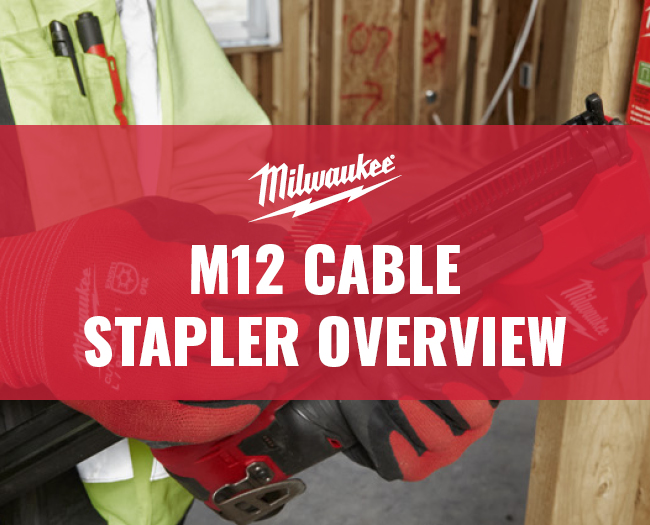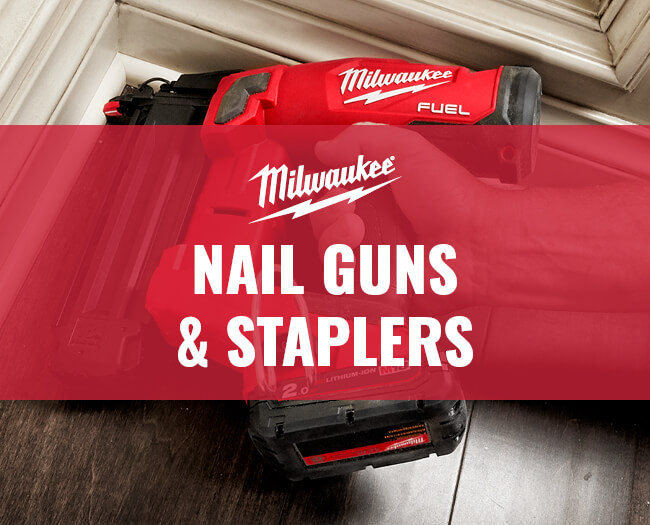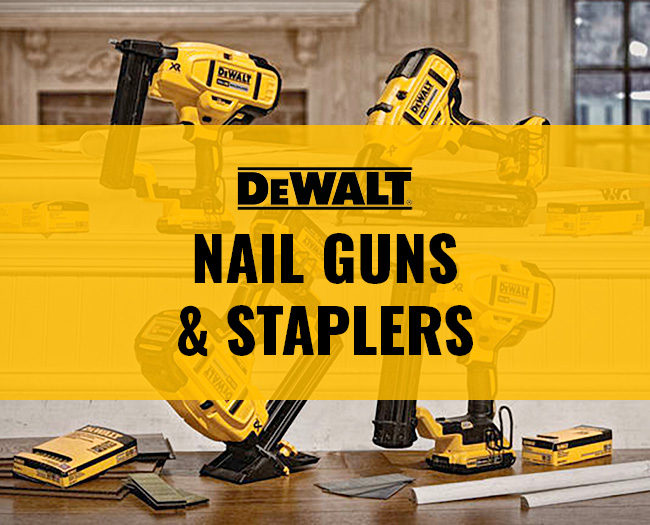
It can be difficult to understand all the nail gun terminology and names thrown around in the trade, especially when starting out as people often refer to the various types of nail gun in many different ways. This can depend upon not only the size of nail they can fire, but also the materials they are able to fire into, and even how the nail guns themselves are powered.
In this article we aim to clear up some of that terminology and with our 40 years of experience in the trade serving people like yourself, we hope we can help you better understand the different types of nail guns and their various applications.
What are the Different Types of Nail Guns?
First things first its pertinent that we know that nail guns can come with 3 different energy sources, this is important because depending on your power source the way you operate, transport and maintain your nail gun can change drastically. Here are the commonly found energy sources you can expect;
Battery Powered Nailers
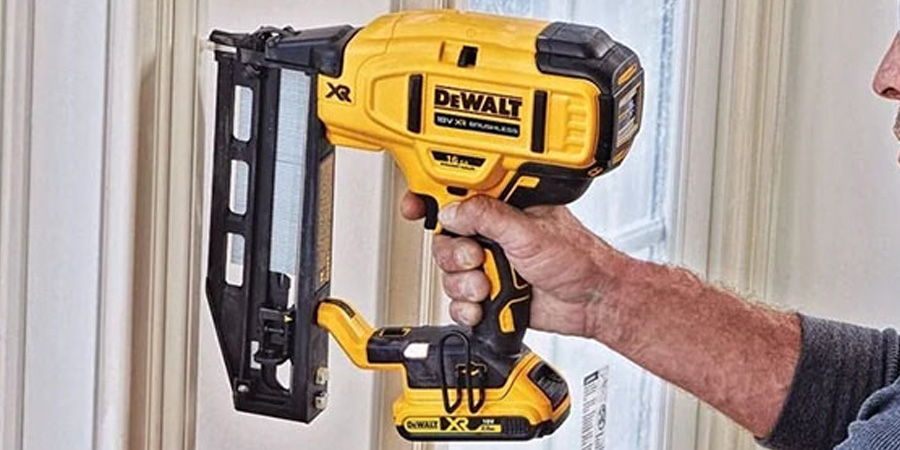
Also know as cordless nail guns, these are probably the easiest to use as they simply take their power from the battery attached to the nailer. No gas canister, air hoses or main power cord required. Put the nails in and you’re ready to go!
Gas Nailers
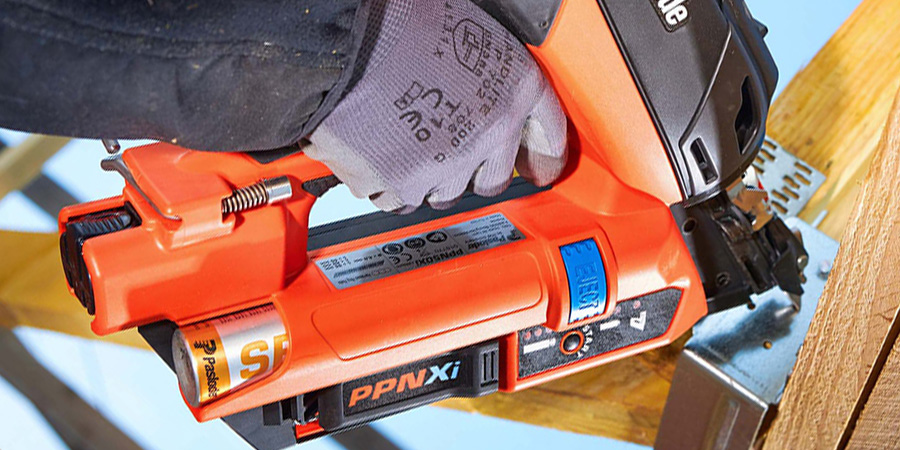
Nothing complicated here, they simply need a gas canister in addition to a battery to get their power. As the gas is usually supplied together with the nails, it’s not as difficult as it might sound.
Air Nailers

These simply used air as their power and requires a compressor to provide the air via an air hose. As these nailers are less portable as a result, they tend to be found more in a workshop environment. Given that they need on compressed air to operate, they tend to be lightweight, easy to use and very reliable.
So What Nail Gun Do I Need?
If you’re wondering which nail gun you need for the job you first want to know what job you’re doing, nail guns can fulfil many “roles” in both construction and DIY, but as a general rule here are some jobs that you can do with each type. We go into detail for each type of nail gun below so if you’re researching a specific job.
- Framing nail guns: Great for Roofing, and structural construction (timber frames etc)
- Positive Placement nail guns: These guns are very precise great for joist hangers and Z clips
- Coil nail guns: Great for Roofing, Cladding + more frequently cement fibre board fixing
- Concrete nail guns: Great for concrete and brick work
- Brad nail guns: Great for carpenters, wood workers etc
- Pin guns: Great for furniture manufacturing and fixing skirting
- Cable staplers: Great for electricians
- Fencing staplers: Great for Landscapers and garden renovation + farm work
- Staplers: Great for securing insulation and various DIY/Carpentry tasks
- Powered hammers: Cant reach with a hammer? These are a godsend.
Dan goes into detail on each type of nail gun in this video, we have also expanded on these points below!
First Fix Nail Guns
First fix nail guns are used primarily to hold structures together. One of the primary applications of first fix nail guns is in timber framing. In this context, these tools are used to join wooden beams, posts, and other structural components, creating a sturdy and robust framework.
First fix nail guns can effortlessly drive nails of varying lengths and gauges into the wood, allowing for efficient and rapid assembly of the timber framing elements. This significantly reduces the time and effort required compared to traditional methods such as using hammers and manual nail driving.
There are also niche “first fix nail guns” such as concrete nailers that are used to secure metal to concrete slabs. Below is a list of some of the different types of first fix nail guns.
What are Framing Nail Guns?
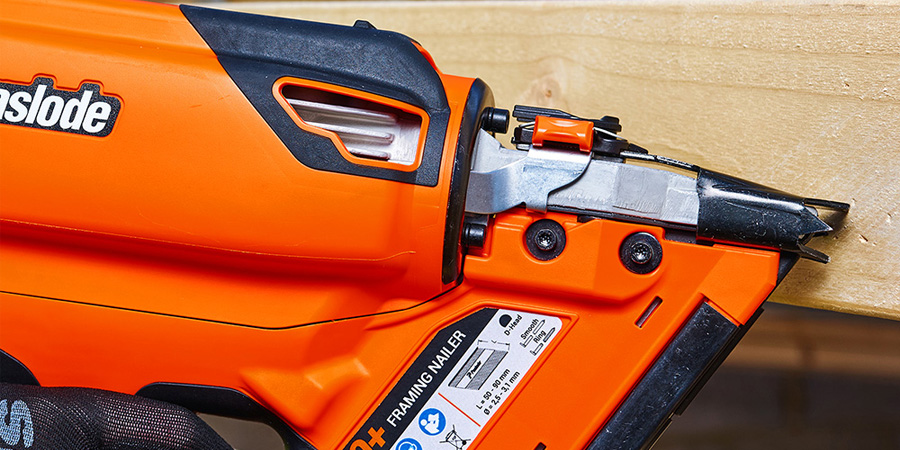
Framing nail guns can also very often be referred to as 1st fix nailers. These are much more of a construction tool. These nailers can be heavy, and they need to be able to pack a punch in order to fire such large nails into tougher timber.
The most common applications would be timber framing assembly work, such as constructing timber stud walls, roofing, building decking bases or fencing. It’s the rough and tough end of the nail gun world.
Large, heavy-duty nails with significant holding power are what you can expect here, and don’t expect to leave a discrete impression where the nail has been fired either, and you will know full well where this nailer has been.
It’s also likely you’ll have a choice of nail type to suit your application, e.g. a standard “Bright Nail” for indoor applications where moisture and rust aren’t a problem.
You’ll also want to use various nails all the way through to galvanised nails and even sometimes stainless steel nails for those applications where you do need to be confident rust won’t be an issue down the road.
Framing Nails are normally “clipped head” and are often available with a “Ringed Shank” for extra holding power. Typically, nails will be around 2.8mm to 3.1mm in diameter. Common nail sizes tend to range from around 50mm up to as much as 100mm.
Framing Nail Gun Applications
- Various roofing jobs
- Building Deck bases
- Fencing
- Constructing timber stud walls
- Timber Frame erecting
Examples Of First Fix Nail Guns
What are Positive Placement Nail Guns?
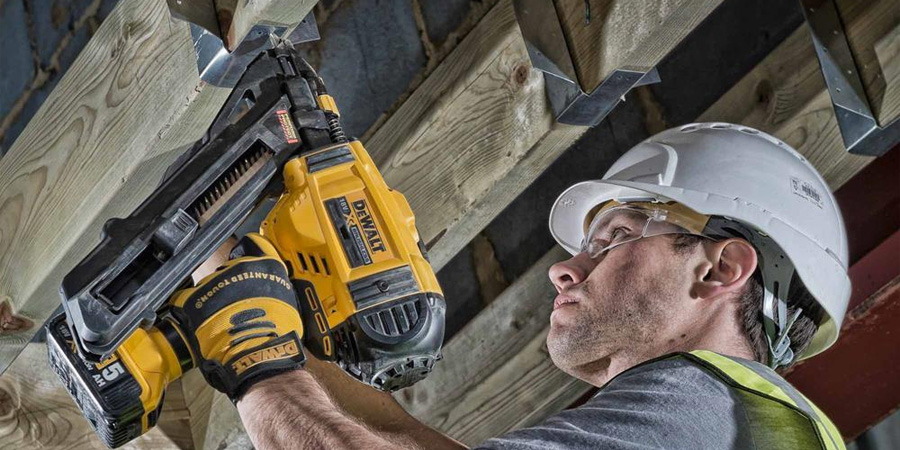
This is where we start to move into the world of very specific professional application nailers. A positive placement nailer is never going to be found in the DIY tool kit. It is a specialist tool designed to do a small range of tasks very well and very quickly.
The clue is in the name “Positive Placement” Put another way, you can be confident that the nail is going to be fired exactly where you intend it to fire.
Doesn’t sound too important unless you are trying to fix joist hangers, sole brackets, connector plates, truss clips, restraint straps or Z-Clips for example, which is where the positive placement nailer is an absolute must. For these types of applications, a positive placement nailer is safer, faster and much more efficient than using a conventional framing nail gun.
This tool most commonly fires a 35mm Full head nail specific to the task.
Positive Placement Nail Gun Applications
- Fixing joist hangers
- Fixing sole brackets
- Fixing connector plates
- Fixing truss clips
- Fixing restraint straps
- Fixing Z-Clips
Examples Of Positive Placement Nail Guns
What are Coil Nailers?
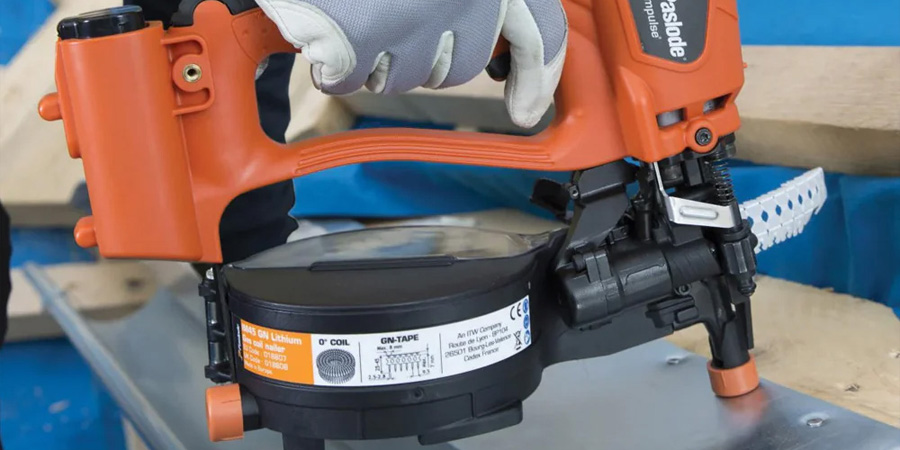
Still in the ‘first fix’ world another specialist gun is the coil nailer AKA a roofing nailer. Designed to carry loads of nails in the magazine (up to around 200) which saves you having to climb up and down ladders to fill up more nails.
These nailers fire a specialist nail (round head 19mm-50mm) designed for fixing roofing felt or other sheet material. More commonly these days they’re used for cladding, fixing cement fibre board (Hardiboard/Hardiplank).
Coil Nailer Applications
- Cladding
- Fixing Hardiboard / Cement fibre boards
Examples of Coil Nailers
What are Concrete Nailers?
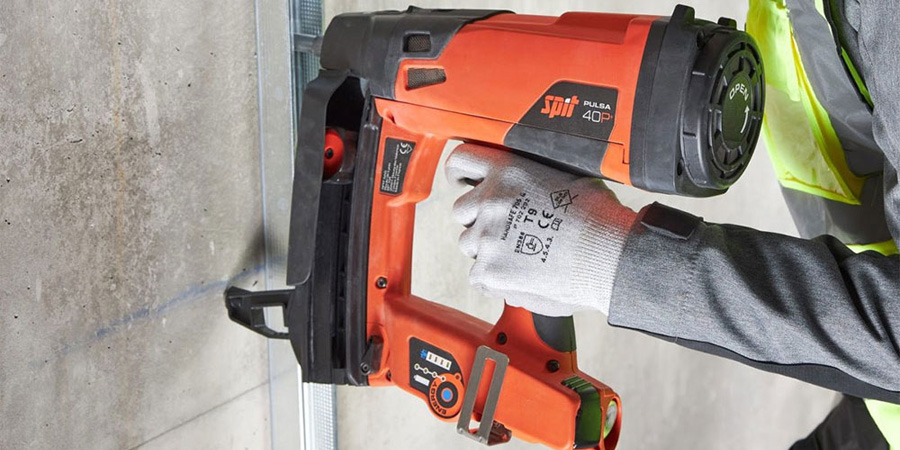
Concrete nailers are very much a specialist professional nailer, sometimes known as a “Powder Actuated Tool” or “PAT” or generically known as a “Hilti Gun” or a “Ramset Gun” should you opt for the versions which utilise explosive cartridges. These nailers are also now available in gas-fired or, more recently, battery-only (gas-free) powered versions.
These nailers are used in construction applications where there is a need to fix hard materials such as steel to substrates such as masonry or concrete. Widespread uses would be tasks such as setting metal stud wall frames to concrete or hanging electrical trunking from pre-cast concrete.
Standard nail sizes range from around 25mm to 100mm but come in wide varieties to suit many applications and will vary depending on the material you want to fire through or into.
Concrete Nailer Applications
- Various construction tasks
- Concrete and brick fixing
- Setting metal stud wall frames to concrete
Examples Of Concrete Nailers
Second Fix Nail Guns
Second fix nail guns, also known as finishing nailers, are essential tools in the realm of carpentry and woodworking. Unlike their first fix counterparts, which are primarily used for structural assembly, second fix nail guns are designed specifically for the finishing touches of a project.
The primary purpose of second fix nail guns is to securely attach smaller and more delicate finishing materials such as trim, moldings, baseboards, crown molding, and decorative elements. These nails are typically smaller in size and gauge compared to those used in first fix nail guns.
The smaller nails are chosen to ensure a discreet appearance, minimizing the visibility of fasteners and preserving the overall aesthetics of the finished project. Below are some examples of Second fix nail guns.
What are Brad Nailers?

Brad nailers are probably the most popular type of nail gun, often referred to as either “2nd Fix” or “Finishing” nailers. These nailers fire “Brad Nails”, which are heavier in gauge (Diameter) than pin nailers.
Brad nails also tend to have a small head and sometimes a serrated shank. As a result, brad nails tend to have considerably more holding power than pins. Although Brad nailers fire a heavier gauge nail than pin nailers, the hole they leave behind on the workpiece is still relatively small and easy to fill over for a great finish. Brad nail guns come in two variations, straight and angled.
Angled Nailers
Angled nailers can get into corners far easier, which can be a huge advantage depending on the application but they can be a little more restrictive in terms of the sizes of nails they can fire (eg 32mm to 64mm).
Straight Nailers
Straight nailers may struggle to get right into that corner but will typically give you more nail size options, often being able to fire nails from a shorter starting point (EG 16m to 64mm).
Brad Nailer Applications
- Attaching skirting boards
- Attaching door trims
- Furniture assembly work
- Securing Heavy Moulding work
Examples Of Brad Nailers
What are Pin Guns?
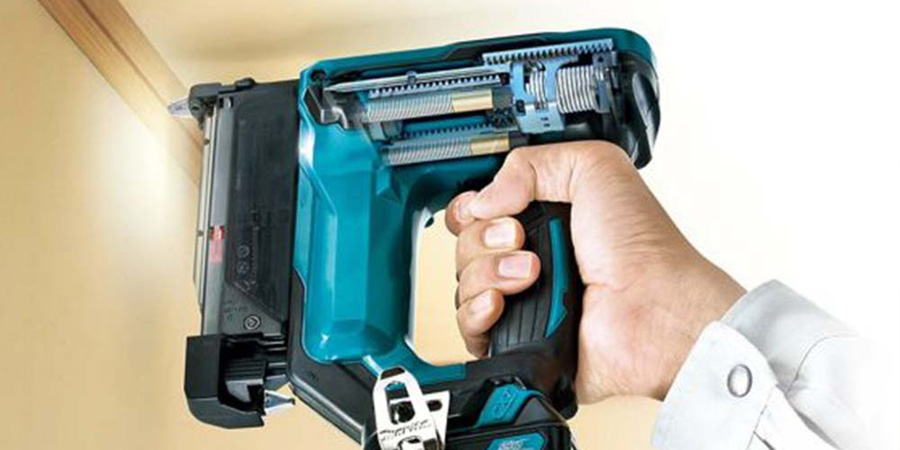
Pin nailers are generally smaller, lighter-weight nailers. Sometimes known as “Headless Pinners”, “Pin Guns”, or “23 Gauge Nailers”.
As the name would suggest, they fire “Pins” rather than “Nails”. Pins tend to be headless and of a tiny gauge (diameter), which is not ideal for applications where holding power is needed.
Pin nailers are mainly used for fine finishing applications such as furniture making, attaching decorative mouldings, assembling picture frames or fastening delicate materials, veneers or trim to pieces of furniture. Often pin nails are used in conjunction with adhesives to hold mouldings in place while they set.
Very little evidence is left behind on the workpiece due to the lack of a head and the tiny diameter of the pin. This makes it very easy to fill over the pinhole and achieve an excellent finish. Common pin sizes range from around 10mm to 50mm and are most commonly around 23 gauge.
Pin Gun Applications
- Picture frame assembly
- Furniture finishing
- Fixing Skirting
- Used to hold adhesive in place
Examples Of Pin Guns
What are Cable Staplers?
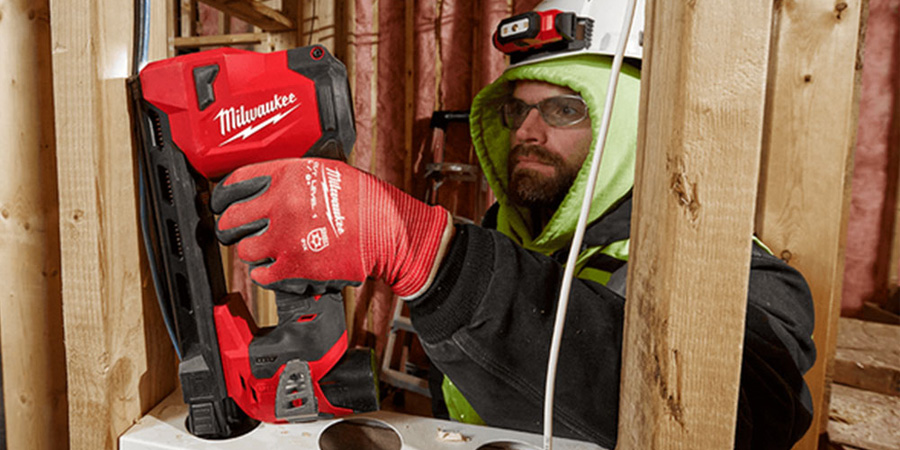
Electricians Cable Staplers are specialist types of staplers designed to speed up the process of running and fixing cables. These staplers are used mainly for fixing twin and earth cables in first-fix applications to timber joists and offer substantial time savings compared to alternative techniques, such as banging in cable clips by hand (with a hammer).
Staples are typically “Insulated Crown” staples which are pre-fitted with an insulated piece along the crown, preventing metal contact with the cable and ensuring both a fast and safe fixing. Staples will generally be around 19mm to 25mm in length, which is all that’s needed for the task.
We have an article looking into Milwaukee’s M12 cable stapler if you would like to do any further reading!
Cable Stapler Applications
- Fitting electrical cables to timber
- House Cable management
- Perfect for spruce
- Installing attic electrical lines
Examples Of Cable Staplers
What are Fencing Staplers?

Fencing staplers, as the name suggests, these are staplers designed specially from wire fencing installation! For those that have seen Clarkson’s farm you know how fun that can be!
These staplers offer massive time savings over doing the job by hand! And offer a much more solid and reliable fixing too. They fire heavy duty staples for around 40mm-50mm and will generally be “Hot Dipped Galvanized” to protect them against rust and corrosion.
Sometimes fixings might be ‘Barbed’ too – which helps even more to increase their holding power!
Fencing Stapler Applications
- Fixing wire fences to wooden supports.
Examples Of Fencing Staplers
What are Standard Staplers?
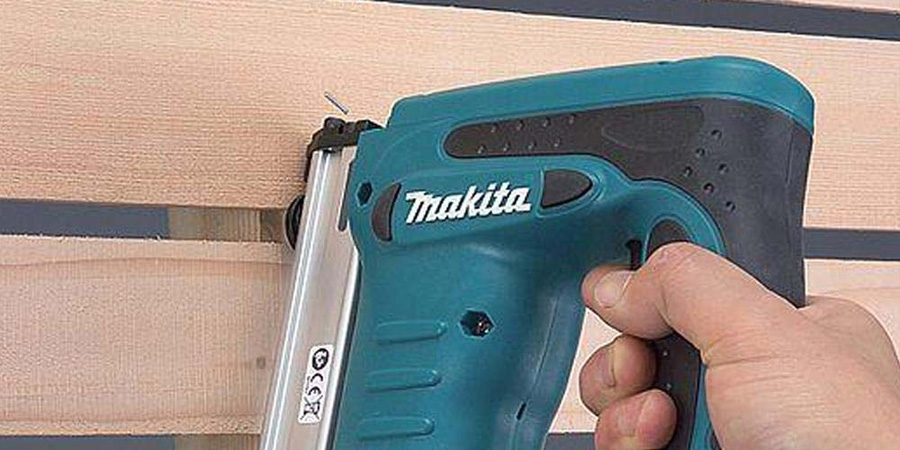
Commonly used in trade and DIY. For a light duty ‘standard’ staple gun we have a few options. Often using normal staples from 6-22mm.
Brands Available: Makita, Hikoki
Standard Stapler Applications
- Securing small pallets
- Carpeting related tasks
- Securing insulation
Examples Of Standard Staplers
What are Powered Hammers / Palm Nail Guns?
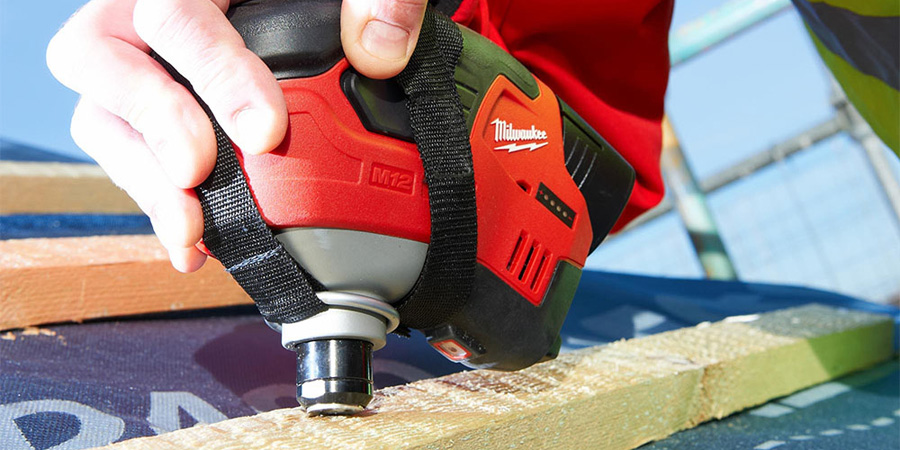
Not strictly a nail gun or staple gun, but these are worth a shout out! Brands have started producing a ‘powered’ ‘cordless’ hammer. Which is making the job of manually hammering in nails and thing of the past. Simply place one of these over the top of your fixing, hit the trigger and watch it do it’s thing!
They’re small, compact and can be used in tight corners of locations where you struggle to swing a hammer! If might seem like a novelty to begin which, but these things have huge potential and can be a life saver!
Powered Hammer / Palm Nail Gun Applications
- Light Framing tasks
- Finishing decking
- Hard to reach metal connector straps
Examples of Powered Hammers / Palm Nail Guns
So there you have it! Hopefully this article has given you an insight into the various types of nail guns, now (if we did a good job) you can confidently choose the perfect tool for your next job or project . From first fix to second fix, nail guns really do make the job much easier and efficient and ITS.co.uk we stock the majority the best brands out there feel free to have a look at some of our other articles below!
Read More about Nail Guns

Nailers Made Easy: A Complete Guide to Types of Nail Guns and Applications – 2024
